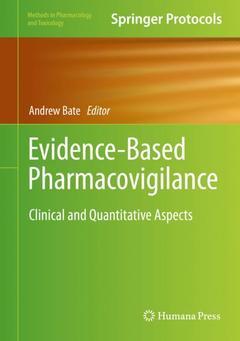Description
Evidence-Based Pharmacovigilance, 1st ed. 2018
Clinical and Quantitative Aspects
Methods in Pharmacology and Toxicology Series
Coordinator: Bate Andrew
Language: English
Subject for Evidence-Based Pharmacovigilance:
Description
/li>Contents
/li>Comment
/li>
1. Congenital Malformations
Eugène van Puijenbroek
2. Pharmacovigilance and the Eye
Anthony P. Grillo and Frederick W. Fraunfelder
3. Pharmacovigilance of Herbal and Traditional Medicines
Li Zhang
4. Pediatric Pharmacovigilance: Current Practice and Future Perspectives
Lise Aagaard
5. Detecting Safety Issues in Clinical Trials
Emma Heeley
6. Developments and Future Directions of Prescription-Based Observational Cohort Pharmacovigilance
Deborah Layton
7. Electronic Health Record, Transactional Insurance Claims, and Distributed Databases in Pharmacovigilance
Kevin Haynes
8. Patient Registries for Safetyness
Marcus Schmitt-Egenolf
9. Patient-Reported Outcomes in Pharmacovigilance
Linda Härmark
10. Evidence-Based Pharmacovigilance for Medicines Used in Public Health Programs in Africa
Haggar Hilda Ampadu, Yvonne Esseku, and Alexander N.O. Dodoo
11. Pharmacoepidemiological Approaches for Population-Based Hypothesis Testing
Olaf H. Klungel
12. Risk Management and Minimization
Yola Moride
13. Benefit-Risk Assessment in Pharmacovigilance
Ola Caster
Concluding Thoughts
Andrew BateProvides an array of methods that strive to ever more effectively protect patients from medicine-related harm
Covers both clinical and quantitative aspects of Pharmacovigilance
Explores how areas in the field may develop in the future
These books may interest you

Pharmacovigilance in Psychiatry 105.49 €



